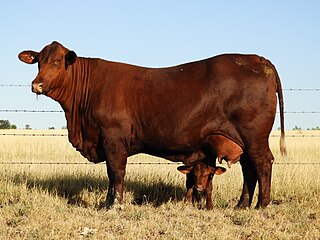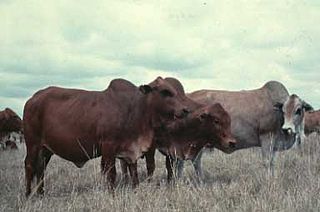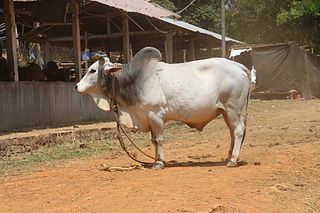
The zebu, sometimes known in the plural as indicine cattle or humped cattle, is a species or subspecies of domestic cattle originating in the Indian sub-continent. Zebu are characterised by a fatty hump on their shoulders, a large dewlap, and sometimes drooping ears. They are well adapted to withstanding high temperatures, and are farmed throughout the tropical countries, both as pure zebu and as hybrids with taurine cattle, the other main type of domestic cattle. Zebu are used as draught and riding animals, dairy cattle, and beef cattle, as well as for byproducts such as hides and dung for fuel and manure. Some small breeds such as the miniature zebu are also kept as pets. In 1999, researchers at Texas A&M University successfully cloned a zebu.

The Tigray Region, officially the Tigray National Regional State, is the northernmost regional state in Ethiopia. The Tigray Region is the homeland of the Tigrayan, Irob, and Kunama people. Its capital and largest city is Mekelle. Tigray is the fifth-largest by area, the fifth-most populous, and the fifth-most densely populated of the 11 regional states.

The Nguni is a cattle breed indigenous to Southern Africa. A hybrid of different Indian and later European cattle breeds, they were introduced by pastoralist tribes ancestral to modern Nguni people to Southern Africa during their migration from the North of the continent.

The Afrikaner, also known as the Africander, is a breed of taurine-indicine ("Sanga") cattle indigenous to South Africa.

The Senepol breed of beef cattle was developed on the Caribbean Island of St. Croix. It has long been thought that Senepol originated from just crosses between N'Dama cattle, imported in the late 19th century, and Red Poll cattle, but it is actually an admixed breed that consists of Red Poll, N'Dama, Criola and a trace amount of Zebu. The Senepol breed combines characteristics of heat tolerance and insect resistance with the docile nature, good meat, and high milk production of the Red Poll. They are polled, short haired, and colored red, black or brown.

The Santa Gertrudis is an American breed of beef cattle. It is a taurine-indicine hybrid breed, descended from both zebu and European cattle. It was bred in the early twentieth century in Texas, and received official recognition in 1940. It has been exported to many countries including Australia, Brazil and South Africa, and has contributed to the development of a number of modern breeds, among them the Barzona and the Droughtmaster.

Boran cattle are a popular Zebu beef breed in eastern Africa.

Dogu'a Tembien is a woreda in Tigray Region, Ethiopia. It is named in part after the former province of Tembien. Nowadays, the mountainous district is part of the Southeastern Tigray Zone. The administrative centre of this woreda is Hagere Selam.

Tanqua Abergele is one of the Districts of Ethiopia, or woredas, in the Tigray Region of Ethiopia. Part of the Mehakelegnaw Zone, Abergele is bordered on the south by the Wag Hemra Zone of Amhara Region, then by the Tekezé River on the west which separates it from North Gondar Zone of Amhara Region, on the north by Kola Tembien, on the east by Degua Tembien and on the southeast by the Debub Misraqawi Zone. The administrative center of this woreda is Yechila; other towns in Abergele include Sele and Jijike. Abergele is one of the low lying districts of central Tigray and the Tanqua River, which originates near Hagere Selam, flows through this woreda and joins the Geba just north of Jijike. It further feeds the Tekezé River. The Tekezé Dam is also located in this woreda.
The Abyssinian Shorthorned Zebu is an Ethiopian breed or group of breeds of zebuine cattle. It is not reported to DAD-IS as a breed.

Sanga cattle is the collective name for indigenous cattle of sub-Saharan Africa. They are sometimes identified as a subspecies with the scientific name Bos taurus africanus. Their history of domestication and their origins in relation to taurine cattle, zebu cattle, and native African varieties of the ancestral aurochs are a matter of debate.

The Malvi or Malavi, also known as Manthani or Mahadeopuri, is breed of zebu cattle from the Malwa plateau in western Madhya Pradesh, in central India. It is a good draught breed; the milk yield of the cows is low.
The Dwarf Lulu is a breed of cattle that is native to the mountains of Central Asia. It has taurine, yak and zebu cattle genetics.

The red and black coated Arado cattle are small and hardy. They are the most common cattle variety in the north Ethiopian highlands. The Arado breed is part of the Zenga breed group. It is essentially reared for draught power, particularly tillage. The breed feeds mainly on crop residues; it is adapted to seasonal feed shortages. This breed is often cross-bred through bull and artificial insemination services.

The long-horned Raya cattle are a breed of cattle common in the Tigray Region of Ethiopia. The Raya cattle have red and black coat colours. Bulls and oxen have thick and long horns and a cervicothoracic hump; cows have medium, thin horns. Raya cattle are closely related to the Afar cattle; this is a result of historical cattle raiding by the Raya people. The Raya cattle are however adapted to draught animals for tillage in the croplands of the highlands.
The Afar cattle are mainly found on the western margins of the Danakil Depression in Ethiopia. The Afar cattle have thick and long horns and a cervicothoracic hump; they are essentially reared for milk production.
Begayt is an Ethiopian breed of cattle. Currently there are ongoing cross-breeding programmes with Arado cattle, in an attempt to increase the milk production of the latter.
Fogera cattle is an Ethiopian breed of cattle. One of its typical characteristics are broad hoofs, that allow it to move more easily in the marshes of the Fogera Plain. At Woreta, the agricultural research centre specialises in preserving the breed.

Tanqua Millash is a district in the Tigray Region of Ethiopia. Located in the Central Tigray zone, Tanqua Millash is a newly created district from parts of the Tanqua Abergelle and Dogu’a Tembien distrcits in 2020. Agbe is the capital of this district.













